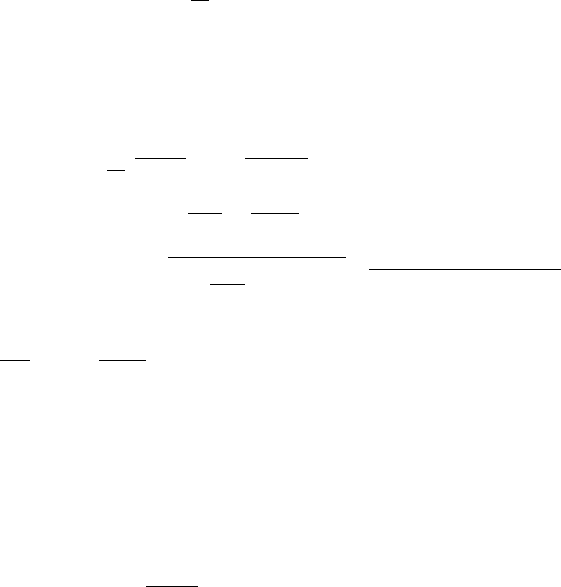Fowler A. Mathematical Geoscience
Подождите немного. Документ загружается.


830 D Melting, Dissolution, and Phase Changes
bands. In this section, we describe a model due to Keller and Rubinow (1981) which
aims to explain the phenomenon, based on the earlier ideas of Ostwald.
Keller and Rubinow consider the reaction scheme
A +B
k
+
k
−
C
p
→D, (D.56)
in which A would represent the silver nitrate seed crystal, B would be the dilute
dichromate solution, C is the reaction product silver dichromate, and D is the solid
precipitate. In one dimension, a suitable set of equations is
a
t
=D
A
a
xx
−r,
b
t
=D
B
b
xx
−r,
c
t
=D
C
c
xx
+r −p,
d
t
=p,
(D.57)
where r is the reaction rate and p is the precipitation rate, given respectively by
r =k
+
ab −k
−
c, (D.58)
and
p =
q(c −c
s
) if c ≥c
n
(> c
s
) or d>0,
0ifc<c
n
and d =0,
(D.59)
where c
s
is the saturation concentration of C and c
n
is the required supersaturation
for nucleation. Let us suppose that D
B
=D
C
, and the reaction is very fast, so that
r ≈0. Then
c ≈Kab, (D.60)
where
K =
k
+
k
−
. (D.61)
Suitable initial conditions are
a =0,b=b
0
,c=d =0att =0, (D.62)
and suitable boundary conditions are
a =a
0
,b
x
=c
x
=0atx =0. (D.63)
Adding the equations for b and c, and defining B =b +c, we obtain
B
t
=D
B
B
xx
−p, (D.64)

D.11 Liesegang Rings 831
and in addition (D.60) implies
c =AB, (D.65)
where
A =
Ka
1 +Ka
. (D.66)
Keller and Rubinow assume that the reaction term r can be neglected in the equation
for a, essentially on the basis that if b
0
a
0
(the dichromate is very dilute), then
very little A is removed in forming the product. In this case A simply diffuses away
from the seed crystal, providing an expression for a as
a =a
0
erfc
x
2
√
D
A
t
. (D.67)
It is convenient to scale the equations, and we therefore choose the scales
d,c,B ∼b
0
,p∼qb
0
,t∼
1
q
,x∼
D
B
q
; (D.68)
then the dimensionless model is
B
t
=B
xx
−p,
d
t
=p,
(D.69)
where
p =
AB −A
s
if AB ≥A
n
(> A
s
) or d>0,
0ifAB < A
n
and d =0,
(D.70)
where we define
c
s
=b
0
A
s
,c
n
=b
0
A
n
. (D.71)
The function A is given by
A =
κ erfcθ
1 +κ erfc θ
,θ=
βx
2
√
t
, (D.72)
in which
κ =Ka
0
,β=
D
B
D
A
. (D.73)
Note that A is a monotonically O(1) decreasing function of θ , which tends to zero
at infinity. The initial and boundary conditions are
B =1,p=0att =0;
B
x
=0atx =0,
B →1asx →∞.
(D.74)

832 D Melting, Dissolution, and Phase Changes
It should be noted that since the time scale is that of precipitation (and thus quite
fast in the laboratory), we can expect the length and time scales to be small, so that
large space and time solutions of this model are of interest.
D.11.1 Central Precipitation
The maximum value of A =
κ
1+κ
is at θ = 0, and thus precipitation will begin at
x = 0 providing
κ
1+κ
>A
n
; we presume this to be the case. Keller and Rubinow
give an ingenious (but heuristic) approximate solution for their model, which we
now emulate. Initially, there is a central precipitating region 0 <x<R(t), where
p>0, and p =0 outside this. First, they suppose that A is slowly varying in space,
and that R is slowly varying in time, so that a quasi-static solution is appropriate.
Since B is continuous at R, then AB =A
n
there, and this solution is
AB =A
s
+
(A
n
−A
s
) cosh(
√
Ax)
cosh(
√
AR)
. (D.75)
For x>R, a stationary solution is not possible, but for slowly varying R,
B =1 +
A
n
A
−1
erfc
x −R
2
√
t
. (D.76)
Equating the derivatives B
x
at R±, we find that R is determined by the relation
√
A −
A
n
√
A
=(A
n
−A
s
)
√
πt tanh
√
AR
, (D.77)
in which A(θ) is given by (D.72), with
θ =
βR
2
√
t
. (D.78)
To solve this, we define
u =
√
AR, (D.79)
and then (D.77) can be written in the form
u tanh u =
2θ
β
√
π
A(θ) −A
n
A
n
−A
s
. (D.80)
The right hand side is a unimodal (one-humped) function of θ, while u tanh u is
an increasing function of u. Therefore u(θ) is a positive function in the range
0 <θ <θ
n
, where A(θ
n
) =A
n
. Consulting (D.77), we see that initially A =A
n
and
thereafter increases with t. Therefore, initially θ = θ
n
and decreases with increas-
ing t. Since A is increasing as is R, u must increase, but it cannot do so indefinitely,

D.11 Liesegang Rings 833
because of the maximum value of u(θ). In consequence, there is a finite time t
∗
when R reaches a maximum R
∗
, and the solution cannot be continued beyond this
time.
Keller and Rubinow go on to suggest that a sequence of precipitation bands will
subsequently form, and they analyse these based on the same approximating solu-
tions. The question arises, whether there is any rational basis for supposing that their
approximation method is valid.
The two principal assumptions in the solution method are that A is slowly varying
in space for x<R, and that R is slowly varying in time. The first of these requires
θ defined by (D.78) to be small, and since A ranges from
A
0
=
κ
1 +κ
(D.81)
to A
n
at x =R, this requires
δ =
κ
1 +κ
−A
n
1. (D.82)
The assumption that R is slowly varying, i.e., that the time derivative in (D.69)
1
can be ignored, requires t x
2
∼ R
2
, and thus, from (D.78), θ β. Assuming
β ∼O(1), as seems likely, this condition is included by (D.82).
We write
θ =δΘ, (D.83)
and then (D.80) can be approximated by
u
2
≈
2δ
2
Θ(1 −a
Θ)
β
√
π(A
n
−A
s
)
, (D.84)
where
a
=
2κ
√
π(1 +κ)
2
. (D.85)
From (D.78) and (D.79), we then find
R ≈
δκ
√
πt
A
0
{βA
0
+(A
n
−A
s
)πκt}
, (D.86)
and R reaches its maximum
R
∗
=
δ
2A
0
κ
βA
0
(A
n
−A
s
)
1/2
(D.87)
at time
t
∗
=
βA
0
πκ(A
n
−A
s
)
. (D.88)
These results provide a basis for a direct asymptotic approach, based, for example,
on the limit δ 1, with the other parameters being taken as O(1).

834 D Melting, Dissolution, and Phase Changes
D.12 Exercises
D.1 The density ρ, velocity u and internal energy e of a fluid are given by the
conservation laws
∂ρ
∂t
+∇.(ρu) = 0,
∂ρu
i
∂t
+∇.(ρu
i
u) = ∇.σ
i
+ρf
i
,
∂
∂t
1
2
ρu
2
+ρe +ρχ
+∇.
1
2
ρu
2
+ρe +ρχ
u
= ∇.(σ
i
u
i
) −∇.q,
where σ
i
=σ
ij
e
j
, q is the heat flux, and the conservative body force f is defined
by
f =−∇χ,
where χ is the potential.
Show that the momentum equation can be written in the form
ρ
∂u
i
∂t
+u.∇u
i
=
∂σ
ij
∂x
j
+ρf
i
,
and that the energy equation can be reduced to
ρ
de
dt
=σ
ij
˙ε
ij
−∇.q.
D.2 The perfect gas law may be written in the form
v =
RT
Mp
,
where R is the gas constant, and M is the molecular weight. Show that β =
1
T
,
and deduce that for a perfect gas,
dh =c
p
dT,
where h is specific enthalpy.
Use the relation
de =Tds−pdv
and the definition of the specific heat at constant volume,
c
v
=T
∂s
∂T
v
,

D.12 Exercises 835
to show that
de =c
v
dT −pdv+T
∂p
∂T
v
dv
[hint: use the Maxwell relations]. Hence show that, for a perfect gas,
de =c
v
dT.
D.3 The functions g
S
(c) and g
L
(c) are defined by
g =Ac +B(1 −c),
for coefficients A
S
and B
S
, and A
L
and B
L
, respectively, and these are defined
by
A = a +RT ln c,
B =b +RT ln(1 −c),
with similar subscripting S,L of the coefficients a and b.
Show that the conditions A
L
= A
S
and B
L
= B
S
are solved by values c
L
,
c
S
which satisfy
g
S
(c
S
) =g
L
(c
L
) =
g(c
S
) −g(c
L
)
c
S
−c
L
.


Appendix E
Averaged Equations in Two Phase Flow
E.1 Discontinuities and Jump Conditions
Suppose we have a conservation law of the form
∂φ
∂t
+∇.F =0, (E.1)
which is derived from the integral conservation law
d
dt
V
φdV =−
∂V
F.ndS. (E.2)
From first principles we can derive the jump condition across surfaces where φ and
F are discontinuous:
[φ]
+
−
=V
n
[F
n
]
+
−
, (E.3)
where +and −refer to the values either side of the surface of discontinuity, and n is
the unit normal at this surface (pointing either way); V
n
is the speed of the surface in
the direction of the normal, and F
n
=F.n. In the common case of a fluid in motion,
where the conservation law takes the form
∂φ
∂t
+∇.(φu) =∇.J, (E.4)
the corresponding jump condition is
φ(u
n
−V
n
) −J
n
+
−
=0. (E.5)
The basic equations of conservation of mass, momentum and energy for a fluid
with density ρ, velocity u and internal energy e weregivenin(D.12), and are re-
peated here:
∂ρ
∂t
+∇.(ρu) = 0,
A. Fowler, Mathematical Geoscience, Interdisciplinary Applied Mathematics 36,
DOI 10.1007/978-0-85729-721-1, © Springer-Verlag London Limited 2011
837

838 E Averaged Equations in Two Phase Flow
∂ρu
i
∂t
+∇.(ρu
i
u) = ∇.σ
i
+ρf
i
, (E.6)
∂
∂t
1
2
ρu
2
+ρe +ρχ
+∇.
1
2
ρu
2
+ρe +ρχ
u
= ∇.(σ
i
u
i
) −∇.q;
in the last equation, χ is the potential energy. The corresponding jump conditions
are
ρ(u
n
−V
n
)
+
−
= 0,
ρu
i
(u
n
−V
n
) −σ
in
+
−
= 0, (E.7)
1
2
ρu
2
+ρe +ρχ
(u
n
−V
n
)
+
−
=[σ .u.n −q
n
]
+
−
.
Note that these jump conditions are implied automatically by the integral forms of
the conservation laws, assuming there is no production at the surface (e. g., of energy
by a surface reaction). Therefore the integral forms can be applied directly to find
the total mass, momentum and energy conservation laws for a two phase flow in
which the density and energy in particular may be discontinuous.
Let us define the interfacial source term
Γ =Γ
−
=−
ρ(u
n
−V
n
)
−
, (E.8)
where we define the unit normal n
−
here to be pointing from the − phase towards
the + phase. If we suppose that there is no slip across an interface, [u.t]
+
−
=0, where
t is any tangent vector at the interface, then the momentum jump condition (E.7)
2
implies
[σ
nt
]
+
−
=0, [σ
nn
]
+
−
=−Γ [u
n
]
+
−
, (E.9)
and the energy jump condition becomes
Γ
1
2
u
2
+e
+
−
+[σ
nn
u
n
−q
n
]
+
−
=0, (E.10)
since we take the potential energy χ to be continuous.
E.2 Averaging Methods
Next, we consider the derivation of averaged equations for two-phase flows. This is
a subject which has been the subject of a number of different investigations, see for
example Ishii (1975) and Drew and Passman (1999), and also the thorough overview
by Drew and Wood (1985). Averaging proceeds as in the derivation of averaged
equations for turbulent flows (see Sect. B.1), but the choice of average is not clear

E.2 Averaging Methods 839
cut. A local space average seems the most obvious choice, but only for homogeneous
flows. A local time average is a better choice, but in fact preference is usually given
to the ensemble average over a number of realisations of the flow. For stationary
flows, this is likely to be equivalent to a local time average.
Further complication arises since often one is concerned with axial flows in a
pipe (for example in a volcanic vent), where a cross-sectional average is appropriate
either as well as, or instead of a local time average. There seem to be few examples
where two-phase models in two or three dimensions are proposed.
There are various different ways to derive averaged equations. We follow Drew
and Wood (see also Fowler 1997) in using an indicator function X
k
which is equal to
one in phase k (k =1, 2) and zero otherwise. We denote averages by overbars, and
the averaged equations are obtained by multiplying the point forms of the governing
equations by X
k
and then averaging. This procedure introduces derivatives of the
piecewise continuous X
k
, and these must be interpreted using generalised functions.
To see how this works, consider a general conservation law of the form
∂
∂t
(ρψ) +∇.(ρψu) =−∇.J +ρf, (E.11)
where ψ is the conserved quantity (per unit mass), u is the fluid velocity, J is the
flux, and f is a volumetric source. Multiplying by X
k
and averaging yields the exact
equation
∂
∂t
(
X
k
ρψ) +∇.[X
k
ρψu]
=−∇.[
X
k
J]+X
k
ρf
+
ρψ
∂X
k
∂t
+u
i
.∇X
k
+
ρψ(u −u
i
) +J
.∇X
k
, (E.12)
where u
i
is the velocity of the interface between the phases, and we assume that
∇f = ∇
¯
f , ∂f /∂ t = ∂
¯
f/∂t, which will be the case for sufficiently well-behaved
f . Derivatives of X
k
are interpreted as generalised functions. Thus, for example,
j.∇X
k
is defined, for any smooth test function φ which vanishes at infinity, through
the identity
V
φj.∇X
k
dV =−
V
X
k
∇.(φj)dV =−
V
k
∇.(φj)dV =−
S
k
φj
n
dS, (E.13)
where j
n
is the normal component of j at the interface, pointing away from phase k.
This suggests that
j.∇X
k
can be identified with the specific surface average of −j.n,
which is consistent with the fact that ∇X
k
is essentially a delta function centred on
the interface.
